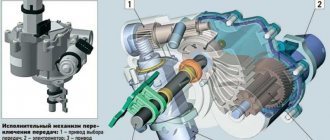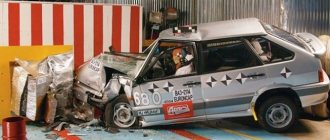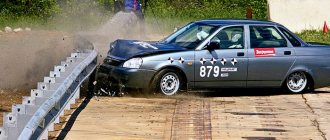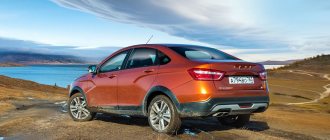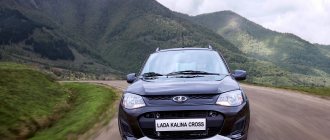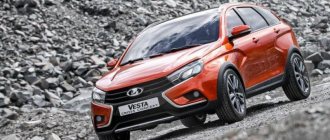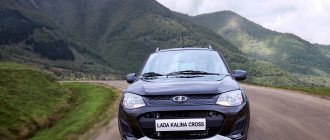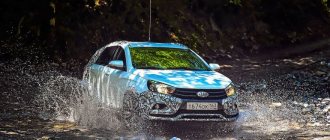Are domestic cars safe or not? This issue causes a lot of controversy to this day, and there are quite a lot of adherents of both one and the other point of view. Everyone is trying to prove that they are right, and after the appearance on the market of new cars from AVTOVAZ - LadaVestaLada and LadaX-Ray, the question has become even more relevant. Information about vehicle safety was collected based on a crash test of station wagons. Under what conditions the tests were carried out, what kind of tests they were, and what the result was - read further in the article.
Pre-production testing of LadaVestaCrossSport
Even before serial production of cars started, comprehensive testing began. It was the month of May 2022. One of these tests was attended by analysts from Autoreview, an authoritative publication trusted in the automotive world. Then the car was tested during a side impact on a ram weighing nine hundred kilograms, there was also a removable tip, and the speed was 50 km/h.
The test vehicle was the most fully equipped car, which contained four airbags. The result exceeded all expectations, and the AVTOVAZ designers were proud of it. Most of the impact energy was absorbed by the threshold, the performance of the side airbags fully met expectations, and the rear windows were not damaged in principle, which cannot be said about the driver's window.
AVTOVAZ reports say that the sensors attached to the driver’s dummy did not detect excessive load. According to HIC (hydrogen induced cracking) standards, which indicate head trauma, a good result was obtained. One Autoreview expert noted an interesting feature. The manufacturer did not test the Cross station wagon version with the luggage compartment loaded, although such a test would seem necessary. Such a test would show how securely the oversized luggage located above the window line is fixed. AVTOVAZ explained why they decided not to conduct such a crash test on the Lada Vesta Cross sw. The reason lies in the very purpose of the car, because it is not designed to transport goods, but is an SUV that has increased cross-country ability, but nothing more.
Related link:
The five most common causes of suspension knocks
The package does not include rear side airbags; even if we consider the most expensive, top-end versions, the cabin will only have side airbags in the front row. This was explained by the fact that the final assessment of testing according to EU standards will not change in any way due to their presence, unless the corresponding active safety systems are installed in the car. According to many experts, those who purchase top-end versions would not mind paying a little extra for additional rear row protection.
Crash test Lada Vesta SV cross – production version
As soon as sales of the car started, station wagons, which were classified as production models, were tested. To assess the consequences of a frontal impact, the ARCAP method (frontal collision with an obstacle at a speed of 64 km/h) was used, and the test was carried out by representatives of the Autoreview publication. A test of the consequences of a side impact was carried out on a specially equipped territory of the AVTOVAZ plant. Repeated full-cycle tests were necessary, since both the ground clearance and weight of the production car had increased.
Who is Danner?
The “insurance” crash test methodology was developed back in the 70s of the last century at the initiative of the international organization for auto repair RCAR (Research Council for Automobile Repairs). The founders, by the way, were the Scandinavians: back in the 60s, on the instructions of the chief of the largest Swedish insurance company Folksam, Claes Back, the Car Repair Committee was created, which began developing a system of ratings for the cost of restoration repairs after an accident that influenced the price of insurance. The Swedish committee quickly grew into a Scandinavian one, then the German research center Allianz Zentrum fur Technik (AZT) and the British research institute Thatcham joined it.
The crash tests themselves were developed under the leadership of AZT executive director Professor Max Danner (hence the second common name for RCAR tests - Danner crash test) together with Mercedes-Benz. The European insurance rating is made up of three ratings: for impacts from the front, rear and side. At Autoreview we use only one RCAR crash test - frontal. Speed - 15 km/h, non-deformable barrier is rotated 80° to the longitudinal axis of the car, overlap at the moment of collision - 40%. It is this type of impact that simulates the most typical urban accident involving a collision with a car in front.
Vesta Cross frontal impact test
Representatives of “Autoreview” purchased a car specifically for testing for 798,000 rubles, which ended up being badly damaged. To assess the consequences, it was necessary to organize a frontal collision with deformable ceilings, speed – km/h. Even before the start of the procedure, specialists noted the presence of large wheels, which is a clear advantage of the car. The top version of the Cross station wagon is equipped with 17-inch wheels, but the sedan can only boast 15-inch wheels. Experts measured the mass of the car, it turned out that it weighs 148 kg more than the sedan, so energy absorption was expected to be 13% more.
Specialists from the manufacturer’s plant were also invited for testing. The first impression after the collision was that the car withstood it perfectly. Due to the additional amplifiers, there was no displacement of the front pillar, and excellent performance of the left spar was noted - it turned out to be folded, and this made it possible to absorb a significant part of the impact energy. One of the alloy wheels cracked from the energy, but also took part of the impact. The excellent work of ERA-GLONASS is noted; almost instantly after the collision, a company employee got in touch. There was virtually no effort required to open the driver's door, and the airbag deployment was also excellent. The table shows what damage the mannequins in the front row received:
Related link:
Adjusting the windshield washer nozzles of Lada Vesta.
| Head and cervical injuries | None. Norm. When the car bounced off during the collision, the driver's head turned, but without any damage to his health. |
| Knee injuries | A slight impact of the right knee on the dashboard, no contact of the left knee with the plastic is noted |
| Damage to the chest compartment | None. The seat belts worked well, the compression force was assessed as normal. During the collision, the steering wheel moved away from the person by thirty millimeters |
| Foot injuries | None. The pedal assembly has moved slightly, but there is no danger to health. |
According to the results of this testing, the car is resistant to frontal impact and received a high score. However, if you test a car according to the progressive European methodology Euro NCAP, the result is not so good, since it is also necessary to evaluate the structural integrity of the passenger seat in the cabin. After removing the decorative plastic that covers the area of the sills and wings, a number of creases in the metal of the rear and front sills are clearly visible. It is known that since 2016, the plant has modified the front sills in cars using thicker metals. Representatives of Autoreview decided to cut the threshold and remove the external linings - as it turned out, the deformation also affected the power unit itself.
After that, we decided to start removing the floor sound insulation, under which a torn floor appeared, that is, the legroom was destroyed, and this is already a reason to deduct one point. The ruptures occurred exactly at the points, but there were no complaints about the welding. Consequently, the sheet metal supplied to AVTOVAZ is not of sufficient quality. The floor of the car under the driver's seat was also deformed, it was raised, and this was an excessive load on the shin area. As a result, the crash test of the Lada Vesta SV Cross actually failed - it earned only a satisfactory rating. The maximum score was 16 points, and Vesta got only 11.7. Minuses were received for the following reasons:
- The lower legs are not sufficiently protected.
- The floor is deformed, according to Euro NCAP standards, this indicates that the doorway is not stable.
- The threshold broke and the dummy hit the plastic steering column. Although it is not dangerous, the plastic covers a number of metal components.
Related link:
Camshaft sensor for Lada Vesta.
The car was given only three stars.
For comparison
Volkswagen Polo. The hood, both headlights, bumper, crossbar with crushed elements, plastic radiator mounting box and air duct are damaged.
Hyundai Solaris. The bumper was cracked, the hood and fender were slightly dented, the headlight and fog lamp housing were destroyed, the front beam and the end of the left side member were damaged
Chevrolet Cobalt. The bumper cover is torn, both headlights are damaged, the front panel, crossbar, hood and left fender are deformed
Peugeot 408. The crossbar and replacement mounts of the left headlight are damaged, the bumper trim is slightly damaged
Renault Sandero. The front beam, engine subframe, front part of the left side member, top panel, front left fender and engine compartment mudguard were deformed. The left headlight is broken, the edge of the hood is dented, the front bumper is torn, the radiator mount is broken
Lada Granta. The radiator frame is crushed and torn, the hood, headlight, both wings, and spar are damaged.
Nissan Almera. The bumper lining was damaged, both headlights were damaged, the front panel, crossbar, side member, subframe, hood and left fender were deformed.
Skoda Rapid. The edge of the hood is jammed, the headlight, bumper trim, crossbar with crushed elements, radiator mounting screen, left fender, fog lamp are damaged.
Geely Emgrand. The hood, fender, amplifier and bumper trim, headlight, and transmission radiator were damaged. The front body panel, side member and mudguard of the engine compartment were deformed
How AVTOVAZ reacted to the test results
The engineers were really puzzled by the results; they decided to buy back the car that was broken during testing in order to examine it, since there was a possibility of defects during the assembly process. However, this option was not confirmed. Then they carried out computer modeling and compared the test results at the plant site and the result of the Autoreview test. It turned out that the reason for this behavior of the car in a collision was ballast. There is an algorithm for preparing a car for testing.
| Weight on front seats (dummy weight) | 88 kg each |
| Indicator of tank fullness with gasoline (gasoline is replaced with water) | 90 % |
| Ballast weight on the rear seat | 32 kg |
| Weight in the luggage compartment required for testing the equipment | 36 kg |
When testing was carried out at the factory, 2 child seats and 2 child dummies were installed on the rear sofa, but in the external test they used metal ingots that were screwed to the floors. The weight of each ingot is 20 kg. Permission to use this approach is given by Euro NCAP standards only when there is a guarantee that it will not affect the test results. A mathematical model was created, and engineers found that the use of two ingots, each weighing twenty kilograms, affected the load on the reinforcements and welds, increasing it by 20%. That's why the floors were deformed.
After this fact was clarified, 2 similar procedures were carried out using metal ingots, and the result was consistent with that. What did the representatives of Autoreview receive? But test 3 was carried out with child dummies, and it gave excellent results. Here we note the excellent work of the belts, the absence of folds in the floor, the metal and welding firmly withstand impact. It turns out that if 2 child dummies had been seated in the car, it would have received almost 15 points instead of 11.7. However, the test results prompted the designers to seal the floors, and they succeeded.
Related link:
What you need to know about running Vesta
Financial expenses
Using an official service, we can calculate the cost of car repairs:
- repair + restoration: 40,000 rubles;
- parts + spare parts: 70,000 rub.
Thus, we get approximately 110,000 thousand rubles. – and this despite the fact that we will be asked to wait 30 days for the missing parts.
A typical auto repair shop will offer prices approximately as follows:
- repair + restoration: 40,000 rubles;
- parts + spare parts: 20,000 rub.
In total, about 60,000 rubles accumulate.
Here's the thing. The official service decided that only the front fender on the left side could be repaired. Other deformed elements only need to be replaced. Accordingly, they would have to be purchased from the same service (beam, bumper trim, and headlight; other parts could be restored).
Drawing a parallel with the financial costs of such restoration for foreign cars, we get what is shown below:
As it is easy to summarize, if your Vesta has outlived the warranty period, restoring it in regular auto repair shops will cost significantly less than repairing cars from foreign manufacturers.
Crash test of Lada Vesta Cross during a side impact
Again, the test result is influenced by the evaluation criteria, as in frontal collisions. Side impacts were already tested at the manufacturer’s premises; we took the top-end version of the station wagon. He will participate in a collision with a cart that weighs 950 kg, has a crushable barrier, and speeds 50 km/h. The central part of the car was chosen for impact. The manufacturer talked about a side cushion that was sewn into the seat backs; in the event of a collision, it should open up, cover the window opening by almost half, and the protection will affect not only the body, but also the head.
After the collision, ERA-GLONASS representatives contacted the car 27 seconds later, which is very prompt. Given the shift in the center of gravity closer to the front, a slight turn of the stern was expected. The driver's window was completely broken, but the rear windows and mirror were not damaged. The chief engineer personally expressed his impression of the test, calling it a success. He noted the timely opening of the side airbag, while experts began assessing the damage in the cabin, recording the forces when opening the doors and other analyses. Only after this they begin checking the condition of the mannequin. When the project was just being worked out, AVTOVAZ employees decided to strengthen the thresholds, because the car’s ground clearance had increased, so it was the threshold that would have to absorb the impact energy. Only with the help of reinforcement could it be possible to minimize the effect of the threshold on the central pillars and the likelihood of their displacement. This was a successful crash test of the Lada Vesta Cross - the video is clear evidence that there were no problems opening the doors after the collision, gasoline did not spill out of the tank, and the dummies did not receive serious injuries, especially since even a tool was not needed to remove them. The battery was intact, there were no dangerous parts in the cabin, and according to the injury criteria, they were all below the threshold standards. The manufacturer does not yet plan to test the car with a full luggage compartment or heavy loads, considering this not so necessary. It is important to note that the European Union already has stricter assessment standards, and Vesta was tested according to standards that were developed back in the eighties. For example, using a cart weighing 950 kg is considered irrelevant. Since almost all modern cars weigh more than a ton. According to the Euro NCAP standard, the weight limit is 1 ton and 300 kg, but the assessment standards are the same.
Related link:
Roof rack sv cross price review
Dummy
True to its promises, AVTOVAZ continued to modernize the Lada Vesta, equipping it with additional equipment and revising the lists of standard equipment.
The Vestas updated in this way have already appeared on the car shelves of the concern’s official dealers. As expected, the process began with the most expensive version of the Russian sedan - Luxe, for which climate control became available to buyers. The system, which replaced the air conditioner, is automatically capable of maintaining the temperature set by the owner in the cabin and quickly clearing frost/fogging from the windows.
The front passengers of the “luxury” Vesta, in addition, received from Tolyatti residents additional guarantees of personal protection due to side Airbags located in the side cavities of the backs of the front seats. According to the designers, in the event of an accident, they will soften the blow to the driver’s upper torso and head, as well as his neighbor on the right, by almost half. The updated Vesta Luxe will cost Russians between 645 and 694 thousand rubles (depending on the type of gearbox and additional options selected).
How are the tests carried out?
According to ARCAP, the crash test is a frontal collision of a car at a speed of 64 km/h with a deformable barrier that simulates the front of a passenger car using aluminum particles. Statistics show that direct collisions are rare, so testing involves hitting the car with an obstacle from the front. Where is the driver? The established overlap size is 40%. This is the ability to simulate an offset, head-on collision between two vehicles having almost the same mass.
Total speed – 110 km/h. 2 mannequins are seated in the cabin, and with the help of sensors installed on them, information about the overloads that act upon impact on such parts of the body as the head, lower leg, chest, kneecaps and hip area is recorded. They examine information on the driver and front row passenger, calculating what injuries they may receive. And with what probability? The calculation takes into account the movement of the steering wheel, the shift of the front left pillars and pedals. Such testing is possible at AVTOVAZ in the Russian Federation, as well as in the Czech Republic, thanks to the specialists of TÜV SÜD Czech
Conclusions and expert assessments
Head-on collision
As a result of the crash test of the Lada SV Cross, problems with the integrity of the body after a frontal impact were identified. The damaged power structure of the threshold and the torn floor under the driver's seat lowered the rating from 4 possible points for leg protection to 1.7 points. In total, Cross receives 11.7 points out of 16 possible. This is 3 stars according to the ARCAP method from the Autoreview auto magazine.
Two years ago, WHA was able to implement a knee joint safety protocol that confirms the safety of the front panel. This is designed to protect the legs of the driver and front passenger from serious injury. The implementation of this protocol adds points to the results of the SV Cross tests - from 11.7 to 15.7 points. In the overall rating, it overtakes the Polo Sedan and is inferior to Solaris.
Lada Vesta Cross safety level
If we evaluate the test result according to the criteria of the Russian plant with child dummies, then it turned out to be simply excellent. There are no floor breaks at the welding points, the thresholds are not swollen or broken. Experts were able to prove that the unsuccessful scores obtained in the external test were due to the fault of Autoreview representatives. The use of twenty-kilogram ingots affected the final results, as they increased the load on the floors. When testing at AVTOVAZ, Vesta SW Cross was able to receive not only 14.9 points, but also a maximum of 4 stars. The car has high safety scores, more than the Lada Kalina, which scored only 10.1 points, and the Grant with a score of 10.7 points.
Related link:
Self-replacement of the light switch on Lada Vesta
LADA Vesta specifications and prices
Select a package to view the basic and additional equipment that is included in it.
- Vesta
- Vesta Cross
- Vesta SW
- Vesta SW Cross
- Vesta Sport
| Equipment | Body | Engine | Power | Box | Drive unit | Overclocking | Speed | Consumption | Price |
| Classic | gasoline 1.6 l. | 106 hp | M.T. | Front | 11.2 sec. | 182 km/h. | 9.3 | 5.5 | 6.9 | 667 900 | |
| Classic Start | gasoline 1.6 l. | 106 hp | M.T. | Front | 11.2 sec. | 182 km/h. | 9.3 | 5.5 | 6.9 | 704 900 | |
| Comfort | gasoline 1.6 l. | 106 hp | M.T. | Front | 11.2 sec. | 182 km/h. | 9.3 | 5.5 | 6.9 | 735 900 | |
| Comfort Winter | gasoline 1.6 l. | 106 hp | M.T. | Front | 11.2 sec. | 182 km/h. | 9.3 | 5.5 | 6.9 | 771 900 | |
| Comfort Multimedia | gasoline 1.6 l. | 106 hp | M.T. | Front | 11.2 sec. | 182 km/h. | 9.3 | 5.5 | 6.9 | 779 900 | |
| Luxe | gasoline 1.6 l. | 106 hp | M.T. | Front | 11.2 sec. | 182 km/h. | 9.3 | 5.5 | 6.9 | 797 900 | |
| Classic Start Plus | gasoline 1.6 l. | 113 hp | CVT | Front | 11.3 sec. | 175 km/h. | 9.2 | 5.9 | 7.1 | 799 900 | |
| Comfort Winter | gasoline 1.8 l. | 122 hp | M.T. | Front | 10.2 sec. | 186 km/h. | 9.5 | 6.2 | 7.4 | 806 900 | |
| Comfort | gasoline 1.6 l. | 113 hp | CVT | Front | 11.3 sec. | 175 km/h. | 9.2 | 5.9 | 7.1 | 830 900 | |
| Luxe | gasoline 1.8 l. | 122 hp | M.T. | Front | 10.2 sec. | 186 km/h. | 9.5 | 6.2 | 7.4 | 832 900 | |
| Luxe Multimedia | gasoline 1.6 l. | 106 hp | M.T. | Front | 11.2 sec. | 182 km/h. | 9.3 | 5.5 | 6.9 | 838 900 | |
| Luxe Prestige | gasoline 1.6 l. | 106 hp | M.T. | Front | 11.2 sec. | 182 km/h. | 9.3 | 5.5 | 6.9 | 860 900 | |
| Comfort Winter | gasoline 1.6 l. | 113 hp | CVT | Front | 11.3 sec. | 175 km/h. | 9.2 | 5.9 | 7.1 | 866 900 | |
| Luxe Multimedia | gasoline 1.8 l. | 122 hp | M.T. | Front | 10.2 sec. | 186 km/h. | 9.5 | 6.2 | 7.4 | 873 900 | |
| Classic Start | n.d. 1.6 l. | 106 hp | M.T. | Front | 12.9 sec. | 170 km/h. | 8.1 | 5.2 | 6.3 | 874 900 | |
| Comfort Multimedia | gasoline 1.6 l. | 113 hp | CVT | Front | 11.3 sec. | 175 km/h. | 9.2 | 5.9 | 7.1 | 874 900 | |
| Luxe | gasoline 1.6 l. | 113 hp | CVT | Front | 11.3 sec. | 175 km/h. | 9.2 | 5.9 | 7.1 | 892 900 | |
| Exclusive | gasoline 1.6 l. | 106 hp | M.T. | Front | 11.2 sec. | 182 km/h. | 9.3 | 5.5 | 6.9 | 892 900 | |
| Comfort | n.d. 1.6 l. | 106 hp | M.T. | Front | 12.9 sec. | 170 km/h. | 8.1 | 5.2 | 6.3 | 905 900 | |
| Exclusive | gasoline 1.8 l. | 122 hp | M.T. | Front | 10.2 sec. | 186 km/h. | 9.5 | 6.2 | 7.4 | 927 900 | |
| Luxe Multimedia | gasoline 1.6 l. | 113 hp | CVT | Front | 11.3 sec. | 175 km/h. | 9.2 | 5.9 | 7.1 | 933 900 | |
| Comfort Winter | n.d. 1.6 l. | 106 hp | M.T. | Front | 12.9 sec. | 170 km/h. | 8.1 | 5.2 | 6.3 | 941 900 | |
| Luxe Prestige | gasoline 1.6 l. | 113 hp | CVT | Front | 11.3 sec. | 175 km/h. | 9.2 | 5.9 | 7.1 | 955 900 | |
| Luxe | n.d. 1.6 l. | 106 hp | M.T. | Front | 12.9 sec. | 170 km/h. | 8.1 | 5.2 | 6.3 | 967 900 | |
| Exclusive | gasoline 1.6 l. | 113 hp | CVT | Front | 11.3 sec. | 175 km/h. | 9.2 | 5.9 | 7.1 | 987 900 | |
| Luxe Multimedia | n.d. 1.6 l. | 106 hp | M.T. | Front | 12.9 sec. | 170 km/h. | 8.1 | 5.2 | 6.3 | 1 008 900 |
The table contains the following data: name of the configuration, body, its engine (fuel, volume, power). Gearbox (MT - mechanical, AT - automatic, AMT - robotic, CVT - variator). Acceleration from 0 to 100 km/h. Maximum vehicle speed. Fuel consumption per 100 km in liters (in the city | on the highway | in the combined cycle). Manufacturer's recommended price for a new car (may not be current, check with your authorized dealer).
